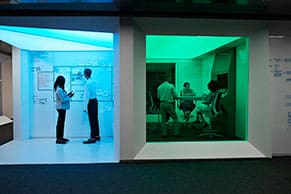When a company properly installs an enterprise resource planning (ERP) system, it becomes that organization’s operational backbone, supporting critical functions from accounting, financial reporting to manufacturing, inventory management, human resources and supply chain management. But the first ERP systems — as we define them today — were implemented more than 30 years ago, around 1990. That’s before smartphones, before graphical user interfaces, and before the internet became a public-facing worldwide web.
Naturally, it isn’t easy to alter your backbone, whether you’re a person or a business. So multiple generations of technological advancement later, many modern, growing, increasingly internet-driven businesses continue to rely on decades-old ERP systems built in the days when a company’s business processes had to adapt to its ERP, rather than the other way around. This reliance on outdated on-premises ERP systems leads to costly inefficiencies in essential business processes that can eat directly into a company’s bottom line.
ERP modernization has become a top priority for growth-oriented businesses facing these realities. More each day are migrating their ERP systems to the cloud — a key requisite for modern ERP — to streamline their operations and ensure they always run on the current ERP software version, complete with the latest features and the most up-to-date security controls. Research firm Gartner, which coined the term “enterprise resource planning” in the 1990s, estimates that 53% of all ERP systems installed in 2021 were cloud-based, and that the cloud’s share of ERP installs will rise to 58% in 2024. To get a sense of the dollar value involved, a separate report from Grand View Research assessed the entire ERP market — on-premises and cloud — at $50.6 billion in 2021, growing to $123.4 billion in 2030.
To modernize successfully, it’s important to understand what ERP modernization can do for your business, the best ways to modernize and how cloud-based systems can add value to your ERP operations.
What Is ERP Modernization?
ERP modernization starts with upgrading an existing ERP system to newer software, accompanied by a migration from on-premises to cloud-based ERP. There are many reasons to modernize ERP, from eliminating the inefficiencies of old processes, to better meeting business needs, to improving ease of use, to better support business growth. But at their core, all these reasons are about flexibility and choice.
To illustrate this point, consider the case of employees who increasingly need access to business data while working remotely from home or on the move. This requires cloud-based ERP solutions that allow users to log in from any location, using any device they choose. Features like mobile access to data make teams more productive and agile, which in turn make their businesses more competitive.
Flexibility and choice in a modern, cloud-based ERP system means that one organization might choose to get all its business functionality, including a unified companywide database, from a single ERP platform provider. But another organization that has already invested heavily in one or two areas, such as customer relationship management (CRM) or inventory control, for example, might keep those systems and be able to integrate them with the same ERP provider’s platform.
Other key attributes that should be part of ERP modernizations are:
- A unified interface. Too many older ERP systems grew by acquisition and integration — but the integrations were sometimes incomplete overlays hiding underlying technologies that remained disparate. Modern cloud-based ERP systems should offer a consistent user interface across the platform, every element of which should make use of the same underlying technology and database.
- A modern, easy-to-use interface. The interface should borrow best practices from web and mobile apps. It should be intuitive, at least in context, and nothing a user needs should be more than a click or two away from wherever they are in the system.
- Real-time data. Batch processes aren’t modern. The fast-paced decision-making demanded of modern organizations requires real-time data shared throughout the ERP system.
- Granular security controls. In a system that enables easy access to crucial data, security controls are critical. Permissions tied to user identities must be highly configurable; IT administrators should be able to establish access based on both the user’s general role and the individual user.
- Self-service customization. Modern workers know how to customize their desktops, mobile and other devices to suit their requirements and work style in a way that makes them personally more efficient. So modern ERP systems must have built-in intelligence that allows such knowledge workers to make their own customizations. It shouldn’t require a third party or someone with ERP expertise to make modifications.
- Adaptability. Modern ERP systems should adapt to your organization’s business processes and help make them more efficient than before. You shouldn’t have to change your business processes to suit the ERP.
- Scalability. Of course, this means scaling up with your business as it grows — but it also means scaling down when, for whatever reason, a business needs to temporarily shrink. Cloud-based infrastructure makes it easy to add resources as you grow, and because cloud pricing approaches don’t require you to buy hardware or software licenses, it’s easier to scale down the monthly bill (or whatever periods your organization signs up for) if times get tough.
These attributes make a strong case for modernizing an older ERP system by replacing it outright but, depending on when the ERP system was installed and its underlying technology, there may be less disruptive modernization options. In the best case, your ERP vendor will help you upgrade an on-premises system to the cloud without needing to rebuild integrations with other business processes.
Key Takeaways
- The goal of ERP modernization is to upgrade or enhance an organization’s older ERP system so that the company can overcome business performance issues and scale for the future.
- The major drivers for ERP modernization are to simplify business processes, increase employee productivity and be able to scale quickly — up or down.
- Cloud-based ERP is a requisite for modernization, as cloud systems bring inherently greater flexibility, adaptability and scalability; deeper insight into real-time data; easier integration with other systems; more intuitive user interfaces; and lower upfront cost.
Why Modernize ERP?
There are numerous reasons to modernize your ERP system. Often, companies upgrade their ERP to resolve issues that their previous systems can’t adequately address, like dwindling productivity or a rising inability to meet customer expectations. Other reasons include a desire for deeper insights into business operations that will help decision-makers boost performance.
Here are three of the most common drivers for ERP modernization.
-
Simplify processes:
Inefficiencies in an ERP system are not only frustrating, but they can also lead to inefficiencies in business operations that incur major costs. In the worst case, slow ERP processes can compromise your relationship with suppliers, especially in the case of invoice payment delays, and with employees — consider the fallout from clunky payroll and resourcing processes. Eliminating these inefficiencies is a major driver for ERP modernization, as new technologies are specifically designed to streamline processes across a business to make it leaner.
-
Increase productivity:
Put simply, modern ERP systems make employees more productive. With access to accounting data on their mobile phones, accounting leaders can quickly sign off on time-sensitive financial reports. With automated payroll processes, human resources leaders can ensure smooth and accurate payment for employees. With real-time supply chain data at their fingertips, logistics leaders can proactively adjust to changes and maintain smooth operations, rather than having to put operations on hold and play catch-up. The list goes on.
-
Support growth:
Growth-oriented businesses generally want an ERP system that can scale in line with their rising sales and footprint without continually incurring new upfront costs or forcing them to make new hires. Cloud-based ERP systems are scalable by nature, as they are not bound by the limits of a business’s on-premises infrastructure. By contrast, many on-premises ERP systems have been so highly customized over the years that even the simplest upgrades are a major headache, making the efficiencies of the cloud even more attractive by comparison.
When Is the Right Time to Modernize?
The best time to modernize an ERP system is before cracks in your previous ERP start to meaningfully affect business operations or customer relationships. As soon as inefficiencies or misalignment between ERP processes start to manifest in the organization’s operations, those issues should be addressed.
There are, of course, some clear indicators of when it’s time to modernize. If employees regularly struggle to access ERP data, if the ERP system requires constant maintenance or if a growing patchwork of processes can no longer keep up with changing demands — be it shifting customer expectations, new business models or evolving compliance needs — ERP modernization is no longer a nice-to-have. It becomes a matter of survival.
5 Ways Cloud ERP Modernizes Your Business
Cloud-based ERP systems do more than modernize business operations. They break barriers between teams and data sources, which transforms the way employees across your organization inform their decision-making. This in turn makes teams more efficient and collaborative, leading to better business performance and improved experiences for your customers. Diving deeper, here are five ways in which cloud ERP takes modernization to the next level:
-
Reduced cost.
On-premises ERP systems incur high infrastructure and implementation costs upfront, not to mention ongoing IT management and upgrade costs over the years. In parallel, misalignment between on-premises systems can slow down other business processes and eat even further into your bottom line. Modern cloud-based ERP systems reduce or eliminate upfront costs. Instead, businesses pay regular fees for access to their ERP software and benefit from automatic updates to the latest version. When delivered as software-as-a-service (SaaS), a cloud ERP also automates many back-end processes, including the transfer of ERP data between systems like finance and payroll, or between procurement and supply chain management.
-
Improved data visibility.
As the backbone of your business operations, ERP systems store and manage data from a number of critical processes, such as accounting, supply chains, warehouse and inventory, human resources, and more. Modern ERP systems allow companies to consolidate all of this data in a single location, empowering business leaders to make insight-driven decisions based on a more complete view of their operations and performance.
-
Streamlined processes.
Cloud ERP systems simplify and automate business workflows, from financial reporting to supplier management to employee payroll. What’s more, they bring a consistent interface to business processes across departments, which makes life easier for employees and allows them to work more efficiently.
-
Seamless technology integrations.
Most cloud-based ERP systems also integrate with third-party IT systems from other vendors, be it your marketing team’s CRM system or your HR department’s talent management solution. In turn, these seamless integrations bring added efficiencies to the way these teams operate and use data to inform their decision-making, without the IT admin headaches that go with patchwork ERP integrations.
-
Enhanced customer experiences.
As with any technology transformation, ERP modernization is ultimately driven by a desire to better serve customers, which drives sales. More efficient business processes lead to enhancements that benefit customers directly and indirectly, which hinge on teams’ ability to access and act on mission-critical data from the ERP system. Cloud-based systems consolidate all of this information in one place, making customer-facing teams more agile and less prone to error so they can deliver better customer experiences.
Is it the right time for ERP modernization?

Modernize With NetSuite
The advantages of ERP modernization are among the main reasons why thousands of growth-oriented organizations have migrated to the cloud-based NetSuite Enterprise Resource Planning System. From internal improvement like greater efficiency and decision-making, to better experiences for workers that help to boost productivity and employee retention, to enhanced customer service and better cash flow, NetSuite cloud ERP customers experience benefits across the board following their cloud ERP implementation.
That said, every company has different goals and priorities for its ERP modernization. If your current ERP is no longer delivering the performance you need, the first step is to build a business case that lays out the goals, costs, opportunities and risks of modernizing. With that, you will have a clear plan of action for your ERP modernization, connecting the dots between the critical business processes you want to improve and the business benefits that a modern ERP system can bring to your organization.
ERP modernization is sweeping companies in every industry and size that want to become more agile, productive and cost-efficient. Cloud-based systems are the most attractive ERP modernization solution, eliminating many of the upfront costs and implementation timelines that made traditional ERP upgrades so daunting and bringing flexibility and choice to the ERP implementation equation. Most importantly, ERP modernization in the cloud turns a business’s ERP into a genuine differentiator, making the business more scalable and agile in the face of growing competition and market pressures.
#1 Cloud ERP
Software
ERP Modernization FAQs
Why do businesses do ERP modernization?
ERP modernization occurs when a company upgrades and/or enhances its older ERP system to address inefficiencies, explore new business opportunities or take advantage of advanced ERP technologies and functionality. For example, modern ERP systems are cloud-based and offer far more technological flexibility and choice than older on-premises ERP, along with the many inherent cost and efficiency benefits of the cloud. Plus, the best cloud-based ERP systems have web-oriented interfaces that are easier to use and are more accessible from a greater diversity of devices than older systems. They also offer greater security controls to help ensure only authorized users enjoy that access. Those superior interfaces support faster, data-driven decisions.
What does ERP mean?
ERP stands for “enterprise resource planning,” a term coined by Gartner in the early 1990s. It refers to software that businesses use to manage day-to-day activities, including accounting, inventory management, human resources, supply chain management, risk and compliance.
What is ERP software used for?
ERP is business software that compiles information from various departments across your business in a common database, enabling leaders to monitor the pulse of a company. ERP systems unify critical business functions, such as finance, manufacturing, inventory and order management, customer communication, sales and marketing, project management and human resources, allowing decision-makers to access data from these departments and conduct detailed analytics and reporting on each.









